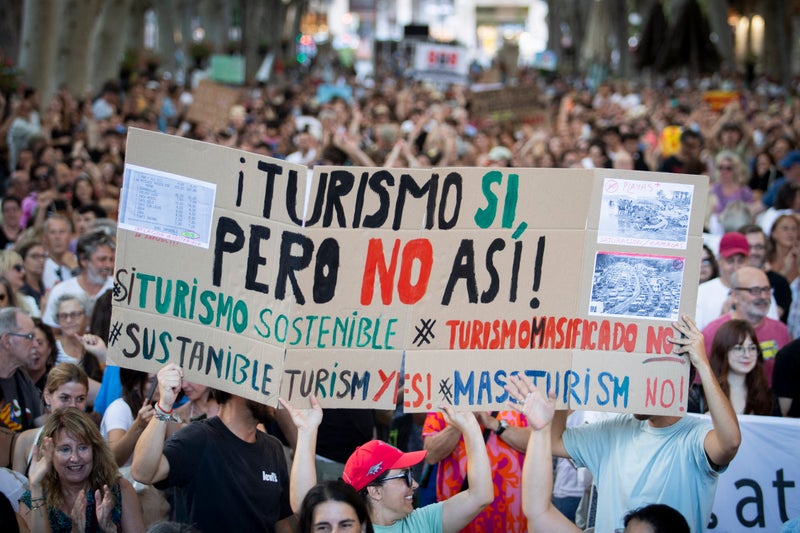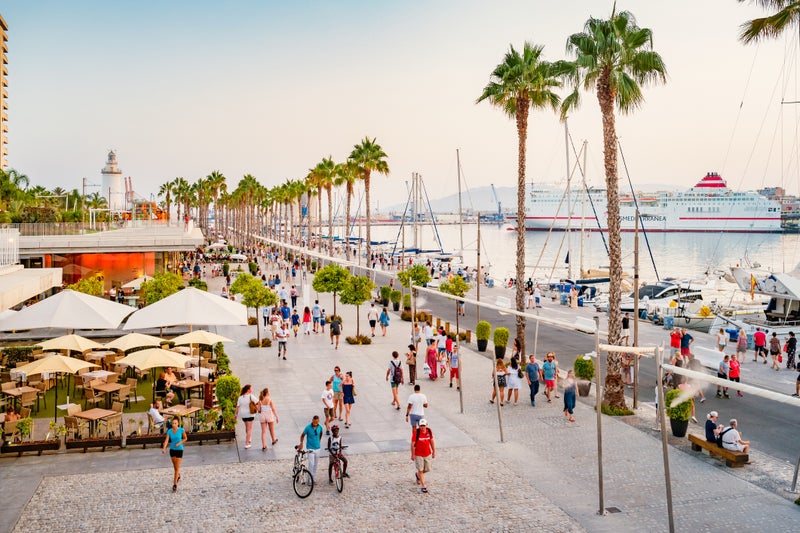A new tourism rule set to take effect in the popular Spanish holiday destination of Mallorca is dividing the nation. As it stands, guided walking tours can accommodate up to 70 in the Balearic Islands. But new requirements in Palma, Mallorca’s capital, will see tours limited to 20 people per group.
![[A huge line of sun loungers with tourists on a beach near Palma Mallorca in Spain]](https://metro.co.uk/wp-content/uploads/2025/02/GettyImages-675761209-86f4.jpg?quality=90&strip=all&w=646)
Tourism agencies such as Proguies Turístics de Baleares have been quick to criticise the decision, while the agency’s president, Gabriel Rosales, has questioned how authorities will monitor groups of 20 if non-paying tourists join a tour ‘on the fly.’.

He said: ‘Are we going to tag them like animals? Or hand out batons to keep out the “unauthorised” tourists?’. Similarly, the Balearic Islands’ Travel Agencies Business Association (Aviba) warned that Mallorca’s tourism would be seriously affected should the measures be implemented.
![[An aerial view of The Cathedral of Santa Maria of Palma, Mallorca, behind the harbour at sunset.]](https://metro.co.uk/wp-content/uploads/2025/02/GettyImages-1254515719-38fd.jpg?quality=90&strip=all&w=646)
Aviba CEO Pedro Fiol says a limit of 20 people would make tours more expensive for both travellers and providers. For businesses, the rule would require hiring more guides, therefore increasing wages. But there’s another problem. Mr Fiol claims Palma does not have enough guides in the first place.
He says this has been a longstanding issue: Over the last 16 years, no new official guide role positions have been advertised. However, the Council of Mallorca says this will change in 2025. As for tourists, Fiol suggests they would inherit the extra costs. Tour prices would inevitably rise, which would have a direct effect on local businesses. As a consequence, visitors would spend less money.
Not everyone is against these new regulations, though. Back in November 2024, a Mallorcan news outlet announced the changes and received several encouraging comments from residents. ‘Groups of 50 people are totally ridiculous in our narrow and busy streets,’ one person wrote, while others agreed that large tours block cars from parking and pulling out safely.
A second commenter noted: ‘To make a meaningful impact, they also need to limit the total number of groups making tours each day. An unlimited number of groups of 20 will create many issues in the most touristy areas.’. Many said they wanted tours to be ‘closed down completely,’ and joked how ‘navigating Olivar market without this will feel less like an assault course.’.
Christian Petzold, Travel & Tourism Expert and Marketing Director at BCN Travel spoke to Metro about the positives of limiting tour group sizes. He said it can be ‘beneficial for individual attention,’ as guides can adequately share ‘fascinating insights into Spain’s cultural, historical, and architectural wonders.’ He noted that larger groups can leave visitors feeling rushed, while guides have difficulties managing them.
At its best, Christian said the change could help to promote deeper storytelling and interaction with tourists. He said the limitation squares well with Spain’s continued dedication toward sustainable tourism, which has seen renewed focus since Covid:.
‘By placing controls on the influx of tourists during any given moment, Spain can protect cultural heritage sites for future generations while allowing the present-day visitors time to view them in a considerate way.’. Finally, Christian noted that the reduction in group numbers should be seen as an opportunity. He said he believes more intimate, niche experiences that cater to travellers looking for authenticity away from mass-market sightseeing tours can be created.
It’s no secret that Mallorca has been impacted by the challenges of over-tourism. Since 2000, the Balearic Islands have seen the largest drop in Gross Domestic Product (GDP) per capita in Spain. The increase in poverty and inequality contrasts with the growing population and tourists the region receives each year. In 2023, over 12.47 million international and domestic tourists visited Mallorca. A year later, this rose to around 13.4 million.
In 2021, it was revealed that almost a fifth of Mallorca’s population is classified as low income, and that four out of 10 islanders had difficulty making ends meet. Recent reports regarding housing in the Balearic Islands emphasise this disparity even further; property prices increased by 20.2% in 2025, making it one of the largest price jumps in Spain.
In terms of limiting tour groups, tourism expert Christian believes the decision addresses several crucial problems that Spain is facing. He said: ‘Overcrowding and over-tourism strain local infrastructure, affect the quality of life of local communities, and lead to environmental degradation. In actively seeking remediation to these issues, Spain is already being proactive in managing the flow of tourists.’.
Spain has been at the forefront of the pushback against overtourism. Last year, Barcelona locals resorted to using water guns to deter rowdy tourists, Venice introduced a controversial day-tripper tax, and hundreds of thousands of locals across Europe took to the streets to protest the damaging effects of overtourism.































